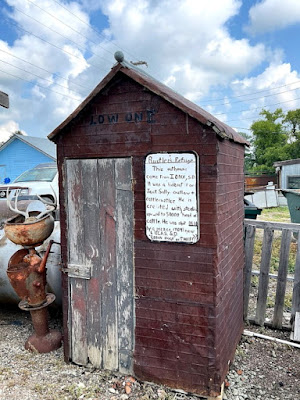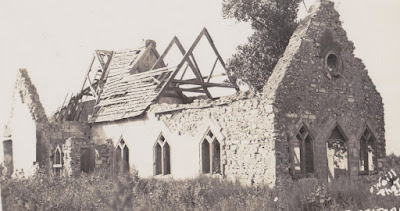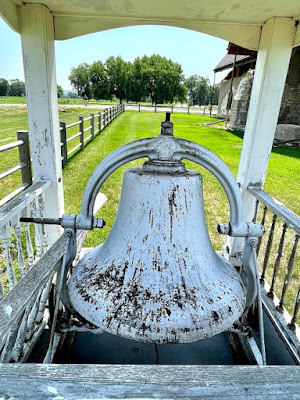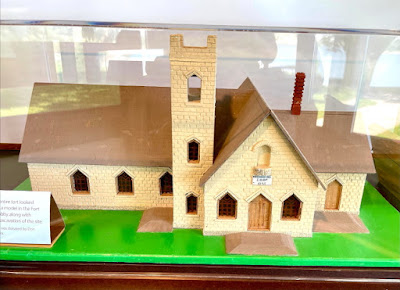Winner (population 2,897) is the county seat of Tripp County. There is a large courthouse located in Winner because the courthouse also serves as the Administrative Center for adjacent Todd County, which does not have its own county seat. Winner received its name when it was first established because the town was considered to be a "winner" as the location of the county's most successful trading point.
A number of nice murals have been painted on some of the downtown buildings. One of the murals recognizes Frank Leahy, who graduated from Winner High School in 1927.
After high school Leahy played football at Notre Dame and then held Assistant Coaching positions at various colleges before accepting the Head Coach position at Boston College. He later came back to his alma mater, Notre Dame, as the Head Coach.
In 1960, Leahy accepted the position as General Manager for the Los Angeles Chargers during their inaugural season in the American Football League.
 |
| Picture by Kolohe |
 |
| Picture by Kolohe |
 |
| Picture by Kolohe |
In 2016 the famous Outhouse Museum was moved from Gregory to Colome (population 296), and now attracts tourists from around the World. The two-story outhouse on display is one of the most popular attractions at the museum -- the top floor is for "Politicians" and the bottom floor is for "Voters." Many people say that they can related to that outhouse!
 |
| Picture by Kolohe |
 |
| Picture by Kolohe |

 |
| Picture by Kolohe |
The two-story outhouse is the most popular facility on display.
The Zimmerman Outhouse was designed for circulating air flow and was originally mounted on wheels for "easy moving when the hole got full." Quite often after Halloween night, the outhouse was found in the middle of Main Street.  |
| Picture by Kolohe |
The smallest outhouse on display was built for a trained circus dog named "King." King was part of the clown group and during performances he would open the door, run inside, and then close the door by tugging on a rope attached to the door.
 |
| Picture by Kolohe |
The Rustler's Refuge belonged to Jack Sully, an outlaw and cattle rustler. Sully is credited with stealing upward of about 50,000 head of cattle. A sign on the building said that he was "shot dead by a pozzee" near Lucas, South Dakota.  |
| Picture by Kolohe |
The Pete Ranch Outhouse is famous because of a gun fight that broke out at a barn dance between Chris Colombe and the ranch hands. (Colombe was the grandson of Pierre Dorian, a fur trader and friend of a Sioux Indian who interpreted for Lewis & Clark.) At the dance Colombe met the rancher's daughter, Emma Shrunk, and started making some advancements. Emma's family did not like Colombe and a gun fight broke out. Colombe hid in the outhouse and the ranch hands shot at the outhouse where he was hiding. Colombe finally escaped with his life and the bullet holes are still visible in the outhouse walls.
 |
| Picture by Kolohe |
Mabel Reed was the first Miss Colome in 1926. She had this special "Porthole Potty" outhouse commissioned to remind her of the many hours her grandparents spent looking out of portholes on the ship they were in as it crossed the ocean while coming to America.  |
| Front View (picture by Kolohe) |
 |
| Side View |
Rattlesnake Pete ran a barber shop and bath house in Dixon, South Dakota. Pete was acquainted with Calamity Jane of Deadwood and was said to have Jane's necklace containing 43 gold nuggets. Before passing, in addition to the bathhouse, Pete started processing and selling rattlesnake skins. After passing, it was discovered that Pete was a lady!
Dallas (population 120) was named after Dallas, Texas. Frank Day's Saloon and Cowboy Museum is located in Dallas and contains items from a number of famous cowboys. The old City Jail is also located on the property.
 |
| Picture by Kolohe |
 |
| Picture by Kolohe |
During the 1930s, the "Dust Bowl" was devastating to farmers in South Dakota. The following photograph was taken in May of 1936 just outside of Dallas.
 |
| By Sloan (?) - United States Department of Agriculture; Image Number: 00di0971 (original link now dead), Public Domain, https://commons.wikimedia.org/w/index.php?curid=2246882 |
Gregory (population 1,295) was part of the "Last Frontier" opened to settlers by the 1904 presidential proclamation that allowed settlers to homestead 160 acres of federal land. By 1905, there were over 250 buildings located in Gregory, including: two banks, a post office, two hardware stores, a meat market, two lumber companies, three hotels, a restaurant, a grocery, a furniture store, a pool hall a photographer's studio, a drug store, two newspapers, and three blacksmith shops. There was also a public school. Land prices went from $3 to $15 per acre in two years.
A large pheasant now greets visitors to "The Ground-Zero of Pheasantdom," as Gregory was described in the March 1992 issue of Fortune Magazine.
 |
| Picture by Kolohe |
 |
| Picture b Kolohe |
As we drove by the community of Burke (population 604), Kolohe took a picture of the town's water tower that came out better than expected, considering how fast I was driving. Burke is the county seat for Gregor County.
 |
| Picture by Kolohe |
Historic Fort Randall Military Post was established in June of 1856 to keep peace on the frontier and to serve as an Army supply depot for the entire Upper Missouri River. The post provided guards and escorted travelers and emigrants across the plains, provide military protection for settlers, settle disputes with various Indian tribes, and prevented trespasses by whites onto Indian reservations. By 1860 the Post had 24 log cabins for the officer's quarters, garrison quarters, commissary, central parade ground, hospital, and a sutler's store. The Post ruins are located on the west side of the Missouri River just south of the current Fort Randall Dam.
The Post cemetery and two other historic buildings that are not on the Fort Randall site are located a short distance to the west.
 |
| Picture by Kolohe |
 |
| Picture by Kolohe |
 |
| Picture by Kolohe |
 |
| Picture by Kolohe |
 |
| Picture by Kolohe |
 |
| Picture by Kolohe |
 |
| Picture by Kolohe |
 |
| Picture by Kolohe |
From top of the Dam there is a road that leads down to the historic Fort site, which is adjacent to the west side of Missouri river. All that remains at the site are some building foundations and the chapel. The chapel was erected in 1875 by off-duty soldiers and served as a combination chapel, library and I.O.O.F. lodge.
The chapel was built in the shape of a cross, using yellow chalk rock and cottonwood lumber that was found in the area. A large bell was installed and it was reported that the bell ringing could be heard for mile around. After the Fort was abandoned, the buildings were sold at auction and the 36-inch, 550-pound chapel bell was moved to the City Hall in Springfield, South Dakota.
In 1953 the Army Corp of Engineers stabilized the chapel and additional restoration work was performed in 2003. After the restoration, the City of Springfield allowed the bell to be returned to the Chapel where it is currently on display.
 |
| Picture by Kolohe |
 |
| Historic Photograph - Photographer Unknown |
 |
| Historic Photograph - Photographer Unknown |
 |
| Picture b Kolohe |
 |
| Picture by Kolohe |
 |
| Picture by Kolohe |
 |
| Picture by Kolohe |
 |
| Picture by Kolohe |
The Fort Randal Dam visitor center is located on the east side of the River in Pickstown, South Dakota. In addition to information on the Dam, the center contains a scale model of the chapel and fossils that were found in the area.
 |
| Picture by Kolohe |
 |
| Picture by Kolohe |
 |
| Picture by Kolohe |
 |
| Picture by Kolohe |























































No comments:
Post a Comment